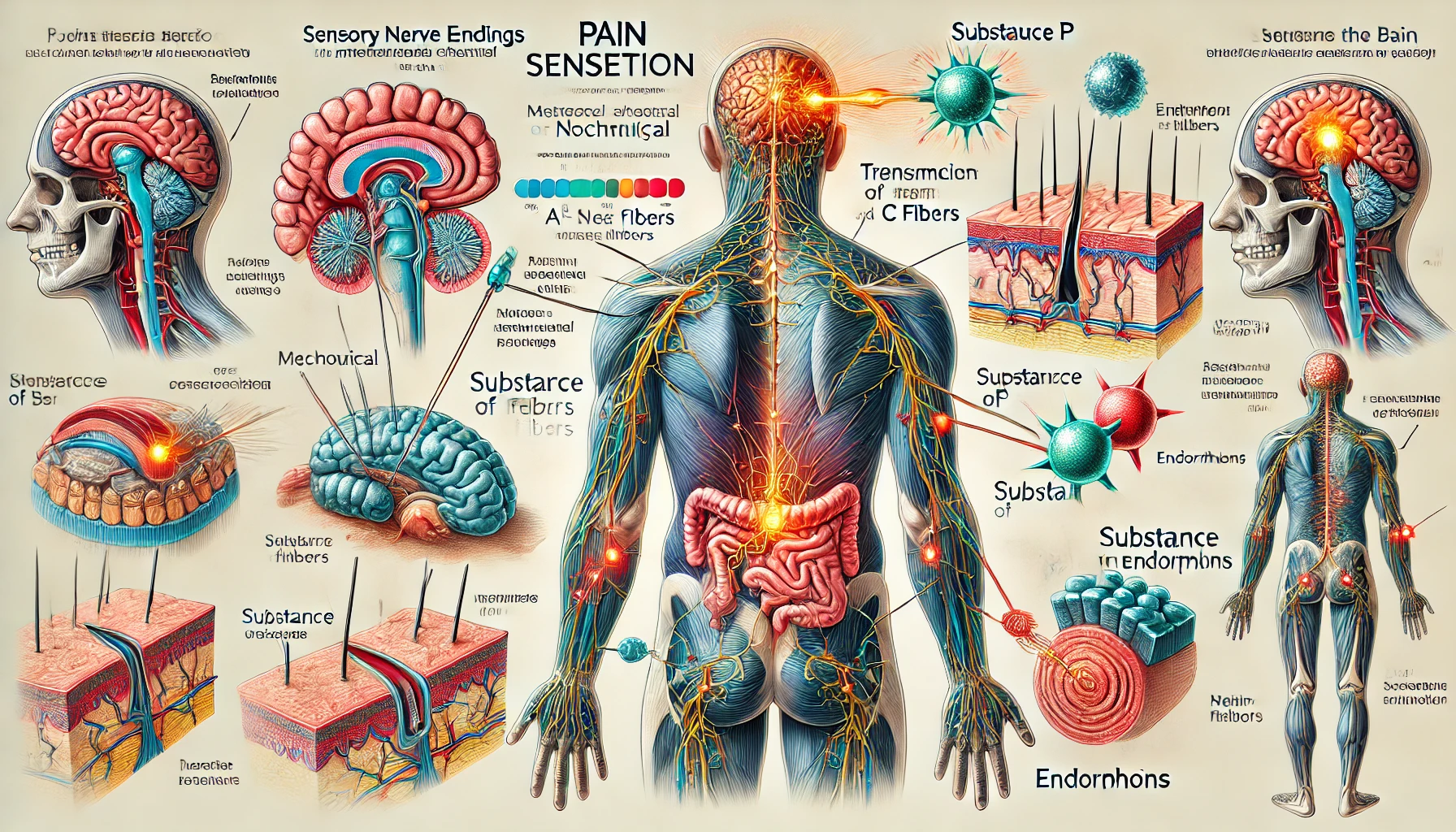Pain is a defense response to tissue damage and is triggered by mechanical, temperature, and chemical stimuli. Pain signals are transmitted to the brain via nociceptors and nerve fibers, and analgesic substances such as endorphins inhibit pain.
Pain is a type of sensation that is a defensive response that gives us conscious awareness when tissue damage has occurred or is about to occur. Stimuli that cause pain include mechanical stimuli from strong physical impacts, irritation from high temperatures, and chemical stimuli from chemicals released by cells when they are wounded or infected by microorganisms. These stimuli are received by sensory nerve endings throughout the body, which are called nociceptors. The skin has the most nociceptors, so it’s easy to pinpoint the location of pain from the skin, but pain from internal organs that don’t have as many nociceptors is harder to pinpoint. For example, pain from organs in the digestive system typically feels more diffuse, and it can be difficult to pinpoint the exact source. This is because visceral pain often radiates to other parts of the organ, or metastasizes.
Sensory adaptation occurs in olfactory and tactile receptors, for example, where the receptor’s response to constant stimulation is reduced. However, nociceptors rarely experience sensory adaptation to constant stimuli. This allows your body to react to dangerous situations. For example, when you sprain your ankle, you initially feel excruciating pain, but over time, the pain seems to dull or subside somewhat, but this is because the response to the painful stimulus hasn”t actually decreased. Rather, this pain triggers a variety of physiological responses in the body that serve to protect the injured area and promote healing.

The main types of nociceptive nerve fibers include Aδ fibers and C fibers. Aδ fibers contain nociceptors that respond to mechanical stimuli or high temperature stimuli, and C fibers contain nociceptors that respond to chemical stimuli as well as mechanical or high temperature stimuli. When pain signals traveling along Aδ fibers reach the cerebral cortex, the cortex feels a short, sharp, tingling initial pain and identifies the location of the pain. When pain signals travel along C fibers to the cerebral cortex, the cortex feels a throbbing, dull, delayed pain. This is related to the characteristics of the two nerve fibers. Aδ fibers have a large diameter and fast conduction speed, while C fibers have a small diameter and slow conduction speed.
The transmission of pain signals from the lower part of the head occurs when stimuli received by nociceptors are converted into electrical signals, which are conducted along primary nerve fibers that connect to the nociceptors, and then along secondary nerve fibers that emerge from the spinal cord and travel through the thalamus to the cerebrum. Primary and secondary nerve fibers synapse with each other in the spinal cord, and neurotransmitters must be released from primary nerve fibers to transmit pain signals. The neurotransmitter glutamic acid is secreted from the terminals of primary nerve fibers and binds to AMPA receptors and NMDA receptors on secondary nerve fibers, activating the receptors. However, NMDA receptors are inhibited by magnesium ions, so only AMPA receptors are activated by small amounts of glutamic acid. When AMPA receptors are activated, sodium ions enter the secondary nerve fibers, causing pain signals conducted along the primary nerve fibers to be transmitted to the secondary nerve fibers, which in turn transmit pain signals to the cerebral cortex via the thalamus. The influx of sodium ions by AMPA receptors is followed by the activation of NMDA receptors, which not only brings in sodium ions but also calcium ions. In this case, the calcium ions do not transmit pain signals to the cortex, but they do increase the sensitivity of the nociceptors, making them more responsive to weak stimuli.
The neurotransmitter substance P is released from the primary nerve fiber endings and activates NK receptors on secondary nerve fibers, which transmit pain signals to secondary nerve fibers. The pain signal travels through the thalamus to the cerebral cortex, where it is perceived as pain, and to the limbic system, which includes several parts of the brain, including the reticular body and hypothalamus, where it stimulates the autonomic and endocrine systems to produce pain-induced behavioral and emotional responses. Pain signals also trigger emotional responses, which play an important role in how individuals experience pain and regulate their responses to it. This suggests that pain is more than just the transmission of neural signals, but also has important psychological and emotional dimensions.
Meanwhile, nerve fiber terminals that extend from the reticular body to the terminals of primary nerve fibers release analgesic neurotransmitters such as endorphins, enkephalins, and dynorphins. By binding to opiate receptors on the terminals of primary nerve fibers, these substances inhibit the release of substance P from primary nerve fibers, preventing pain signals from being transmitted to secondary nerve fibers. This pain inhibitory system allows the body to tolerate pain in traumatic situations by reducing or preventing the sensation of pain. For example, in situations where you are injured and still fighting for survival, the pain is temporarily relieved so you can perform necessary actions. These systems are also important for people with chronic pain, as chronic pain can reduce quality of life due to constant pain signals, making proper pain management and inhibition essential.
 I’m a blog writer. I want to write articles that touch people’s hearts. I love Coca-Cola, coffee, reading and traveling. I hope you find happiness through my writing.
I’m a blog writer. I want to write articles that touch people’s hearts. I love Coca-Cola, coffee, reading and traveling. I hope you find happiness through my writing.